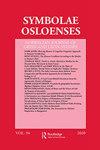The Augment Use of Εειπε and Ειπε in Early Epic Greek: An Evidential Marker?
IF 0.1
3区 历史学
0 CLASSICS
引用次数: 2
Abstract
This article is part of an ongoing investigation into the meaning, origin and use of the augment in Early Greek prose and poetry and discusses the use and absence of the augment in the forms of the simplex ἔειπον/εἶπον in early epic Greek (Homer, Hesiod and the Homeric Hymns). I first explain why this verb was chosen and then proceed to determining the corpus. I start by listing the criteria to determine which forms are metrically guaranteed; when a form is not secured by the metre, I use the “Barrett–Taida” method, which analyses metrically insecure forms by comparing them to the metrically secure forms of the same paradigm and to the attestations and positions in the verse. The corpus that is thus established is then analysed by using previous scholarship on syntactic constraints (Drewitt–Beck’s clitic rule and Kiparsky’s “conjunction reduction” rule) and on the semantics (Koch–Basset’s distinction of narrative versus speech and Platt–Bakker–Mumm’s theory of recent past versus Hoffmann’s remote and timeless past); special attention is also paid to the exceptions. At the end, I investigate if the augment use in epic Greek can be explained as a visual evidential marker.早期希腊史诗中Εειπε和Ειπε的扩展使用:一个证据标记?
本文是对早期希腊散文和诗歌中增词的意义、起源和用法进行研究的一部分,并讨论了早期希腊史诗(荷马、赫西奥德和荷马赞美诗)中增词以单纯形ν ειπον/ε ιπον形式的使用和缺失。我首先解释为什么选择这个动词,然后继续确定语料库。我首先列出确定哪些表单在度量上得到保证的标准;当一个形式不受节拍的保护时,我使用“巴雷特-泰达”方法,通过将它们与相同范式的节拍安全形式以及诗句中的证明和位置进行比较,来分析节拍不安全的形式。这样建立的语料库然后通过使用先前的语法约束(Drewitt-Beck的clitic规则和Kiparsky的“连接还原”规则)和语义学(Koch-Basset的叙事与言语的区别以及普拉特-贝克- mumm的最近过去理论与霍夫曼的遥远和永恒的过去理论)来分析;对例外情况也给予特别注意。最后,我研究了希腊史诗中的增词用法是否可以解释为一种视觉证据标记。
本文章由计算机程序翻译,如有差异,请以英文原文为准。
求助全文
约1分钟内获得全文
求助全文

 求助内容:
求助内容: 应助结果提醒方式:
应助结果提醒方式:


